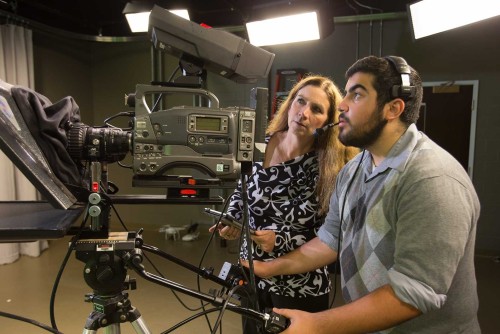Communication majors finding success in fast-changing field
The program is evolving in step with technological advances and social trends to give students the skills and flexibility to capitalize on emerging opportunities.
Communication major Michael Caliri ’18 is a perfect example, someone who has navigated both the traditional communications settings and those currently evolving.
He started out as a journalist, working for local media outlet Wicked Local. But after a few months, a contact he’d made reached out to him about a startup called DraftKings and an opening in its internal communications department.
He got the job at the fledgling fantasy sports and sports betting company and gained valuable experience in a four-year period when DraftKings went from being a U.S.-based company with 900 employees to being a publicly traded global entity with over 5,000 employees.
Caliri then joined internal communications for Deloitte, one of the Big Four international accounting firms and a company with revenue of more than $60 billion a year.
“I wanted to see what life would be like at a larger, established company,” Caliri says.
“I wanted to continue to push myself and try new things.”
And he continues to do so, having recently transitioned from Deloitte to Amazon, where he works in internal communications at the company’s Manhattan offices.
Professor Ron Leone, chair of the Communication & Media Studies Department, says that those sorts of left turns are common in the major — and that they’re one of the department’s strengths.
Graduates find success and employment in a lot of different fields. We have graduates in journalism; students working in publicity and public relations; and others who sit for the LSAT and become lawyers. Some students go straight into Hollywood jobs, studios, film production and marketing.
“There are very few straight paths,” says Leone, who has worked at Stonehill for over two decades. “Graduates find success and employment in a lot of different fields. We have graduates in journalism; students working in publicity and public relations; and others who sit for the LSAT and become lawyers. Some students go straight into Hollywood jobs, studios, film production and marketing.”
Margaux Fleuranges ’10 has held public relations positions at boutique agencies and corporate communication positions at NBCUniversal and Univision. But her interest in the field can be traced back to a Stonehill tour guide who demonstrated excellent communication skills even while walking backward.
“Stonehill was the last of many colleges I saw on my New England college tour,” says Fleuranges, who is currently working as a corporate communications consultant for a startup brand. “I fell in love with the campus, and my tour guide was so great.”
Reflecting on the numerous professional opportunities she has had since graduating, Fleuranges sees a parallel with how she wound up on Stonehill’s 387-acre campus in Easton, Massachusetts. “With a lot of the things I’ve done in my life, I can point back to Stonehill,” she says. “If it’s not a straight line, it’s a wiggly one.”
Fleuranges intended to be a lawyer after college, and for her first three years at Stonehill she was a political science major. When she studied abroad in Italy during her junior year, she’d already completed her poli-sci coursework; all she had left were electives. “So, I took a ton of communication classes,” Fleuranges recalls. “I enjoyed it all so much that when I came back from Italy, I made the decision to declare a minor in communication.”
This led her to a public relations class her senior year. “I loved it so much that I decided to apply to grad school in media studies. And from there I started interning, taking my grad classes at night,” she says. “I took a major left turn, and I never would have done it if not for Stonehill and how the College enabled me to expand my horizons.”
Leone notes that the way the world communicates has changed in the years he has been teaching. “We have students writing and directing feature films and working for major shows like Yellowjackets and Brooklyn Nine-Nine — but for every student making that type of traditional, long-form content, we have 20, 30, 50 students making new kinds of content.”
To reflect these changes, Leone has made sure his program evolves with technology and student desire. One significant change is imminent: Students will now be able to declare a major or establish a concentration in digital media production.
“Being proficient in expressing yourself in short-form content creation is an important skill to be taught in communication programs,” Leone says. “It’s not the future, it’s the present. It’s how we communicate today.”
Callie Silvey ’25 says she was swayed to become a communication major by all of the potential career paths available.
“The breadth really struck me,” she said. “Sports media, social media, film and TV. Being able to do all of those things with my degree and having so many options is really exciting.”
Silvey, who is also majoring in theater, hopes to launch her career in the world of film and television, possibly focused on social media.
“My experiences in the program make me confident, whatever I decide to do.”
Related
-
Join Us for Open House, November 16
Come meet the Stonehill community and explore our 52 majors and 56 minors with our supportive professors, while also getting advice on admission and financial aid. Learn how our internship, research and study abroad programs position our students to take the lead in a 21st century economy.
-
Communication Major & Minor
The Communication & Media Studies Department at Stonehill helps students develop deep understanding of the theories and humanistic approaches used in the field.
-
Thriving in a New Media World
Stonehill’s Communication program is equipping students with the experiences and knowledge needed to navigate today’s increasingly complex — and largely digital — information landscape.



